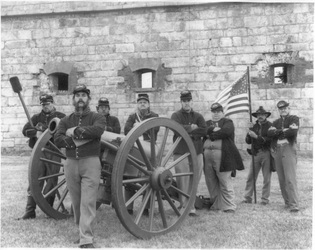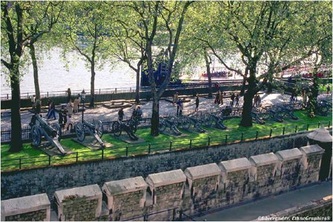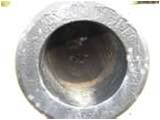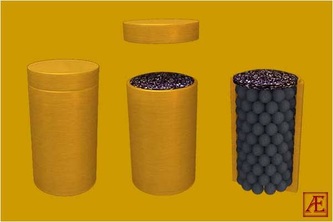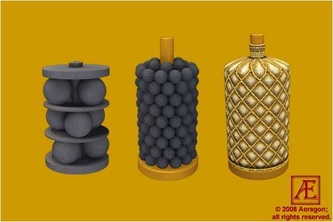Artillery
All firearms larger than small arms are known as artillery or cannon. Although there were dozens of different types of cannon used during the Civil War, they all fell into one of two categories: smoothbore or rifled cannon. They were further designated by the weight of their projectile (12-pounder, 24-pounder, 32-pounder, etc.), the caliber or size of their bore diameter (3-inch, 8-inch, 10-inch), method of loading (breech or muzzle), and often their inventor or the factory in which they were made (i.e. Dahlgren, Napoleon, Rodman, Parrott, Whitworth). A further distinction involved the path of their trajectories: guns had a flat trajectory, mortars a high, arching path, and a howitzer a trajectory between the other two. Civil War artillery was also classified according to its tactical deployment, including field, seacoast, and siege artillery. Cannon were made of steel, bronze, or iron, depending on the availability of material.
Most Used Artillery
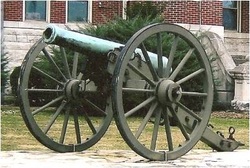
The favorite artillery piece in both the Union and the Confederacy was the Napoleon, a smoothbore, muzzle-loading, 12-pounder "gun-howitzer." Developed under the auspices of Louis Napoleon of France, it first appeared in the American artillery in 1857. Relatively light and portable, the Napoleon was used as both an offensive and defensive weapon by both armies. Initially made of bronze, Napoleons were cast from iron when the South ran short of the other metal. Its maximum effective range was about 1700 yards, but it was most effective at about 250 yards or less. Firing canister the Napoleon probably inflicted more casualties than all other artillery pieces combined
The most used rifled Cannons were the 3-inch Ordnance and 10-pdr Parrott rifles. These cannon were more accurate and had a longer range - up to about 2,300 yards - than their smoothbore counterparts. During most battles, however, the longer range was unnecessary and relatively ineffective. During this period, a gunner had to see his target in order to shoot with any accuracy, and the shorter range Napoleons were adequate for that purpose.
Very frequently used was canister; which, like its larger cousin, "grape shot," was a scattershot projectile consisting of small iron balls encased in a container. Canister projectiles came packed in a tin can while grape shot was usually wrapped in a cloth or canvas covering and tied with string which made it look like a bunch of grapes. When fired, the can or wrapping disintegrated, releasing the shot in a spray. In effect, then, a gun loaded with grape shot or canister acted like a large, sawed-off shotgun; it was particularly lethal when fired at a range of 250 yards or less. Grape was less often used by the field artilleries of the day as it was more effective to fire the smaller and more numerous canister balls at an advancing enemy. Thanks to its superior industrial strength, the North had an overall advantage over the South in all types of artillery, as well as a higher percentage of rifled cannon to smoothbore cannon.
Other Artillery
However, rifled cannon were particularly effective in knocking down fortifications and played decisive roles at Vicksburg and Atlanta. Almost all Civil War cannon were muzzle loading; breech-loading models, such as the British 12-pounder rifled Armstrong and Whitworth cannon, were generally unreliable and awkward. The 12-pound mountain howitzers were among the smallest and most portable artillery and were useful in battles fought in the mountainous regions of the Western theater. Naval and siege cannons, including Dahlgren's and Rodman smoothbores, were among the heaviest and most powerful. The 8- and 10-inch siege howitzers had ranges of over 2,000 yards and could fire 45- and 90-pound shells. Artillery ammunition included solid shot, grape, canister, shell, and chain shot, each of which came in any of the nine common artillery calibers. Solid shot and shell were used against long-range, fixed targets such as fortifications; chain shot, consisting of two balls connected by a chain, was used primarily against masts and rigging of ships.

